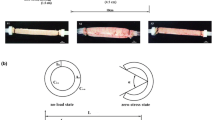Abstract
Purpose
Post-surgical complications are correlated to the surgeon’s technical skill level. Thus, efforts are being put in finding ways to improve the surgeon’s technical skills, such as not causing unwanted damage to tissues during surgery. In this study, we aim to investigate the possibility of estimating biological tissue damage, in view of preventing unwanted damage during surgery.
Methods
A series of tensile tests were performed on porcine small intestinal tissue to determine the elasticity and the tearing force. The tissue was then microscopically observed to investigate the influence of fibrous protein configuration in the tissue’s mechanical properties.
Results
The results from the tensile test showed that the fracture energy had a positive and linear correlation with the elasticity to the negative 0.5th power (R2 = 0.897), which was also suggested by an existing damage model for polymeric materials (Lake-Thomas model). The results from the microscopic observations also showed a resembling influence of fiber configuration on the elasticity as suggested in polymer mechanics (affine network model).
Conclusion
We showed that the fracture energy had a correlation with the elasticity in porcine small intestinal tissues, which was also suggested in polymer mechanics, thus being a promising avenue toward the ability to estimate the maximum applicable force onto a biological tissue without causing damage during surgery. Attention should also be pointed, however, towards investigating the extent at which polymer mechanics and biomechanics overlap.






Similar content being viewed by others
References
Keller DS, Delaney CP, Hashemi L, Haas EM (2016) A national evaluation of clinical and economic outcomes in open versus laparoscopic colorectal surgery. Surg Endosc 30:4220–4228. https://doi.org/10.1007/S00464-015-4732-6
Quinn CM, Bilimoria KY, Chung JW, Ko CY, Cohen ME, Stulberg JJ (2018) Creating individual surgeon performance assessments in a statewide hospital surgical quality improvement collaborative. J Am Coll Surg 227:303-312.e3. https://doi.org/10.1016/J.JAMCOLLSURG.2018.06.002
Stulberg JJ, Huang R, Kreutzer L, Ban K, Champagne BJ, Steele SR, Johnson JK, Holl JL, Greenberg CC, Bilimoria KY (2020) Association between surgeon technical skills and patient outcomes. JAMA Surg. https://doi.org/10.1001/jamasurg.2020.3007
Kim U, Lee DH, Yoon WJ, Hannaford B, Choi HR (2015) Force sensor integrated surgical forceps for minimally invasive robotic surgery. IEEE Trans Rob 31:1214–1224. https://doi.org/10.1109/TRO.2015.2473515
Shiwarski DJ, Tashman JW, Tsamis A, Bliley JC, Blundon MA, Aranda-Michel E, Jallerat Q, Szymanski JM, Mccartney BM, Feinberg AW (2020) Fibronectin-based nanomechanical biosensors to map 3D surface strains in live cells and tissue. Nat Commun. https://doi.org/10.1038/s41467-020-19659-z
Payan Y, Ohayon J (2017) Biomechanics of living organs: hyperelastic constitutive laws for finite element modeling. Biomech Living Organs 347–357
Murakami S (1987) Progress of continuum damage mechanics. JSME Int J 30:701–710. https://doi.org/10.1299/JSME1987.30.701
Lake G, Thomas A (1967) The strength of highly elastic materials. Proc R Soc Lond A 300:108–119. https://doi.org/10.1098/RSPA.1967.0160
Kuhn V (1936) Beziehungen zwischen Molekfilgr6fle, statistischer Molekiilgestalt und elastischen Bigensehaften hoehpolymerer Stotfe. Kolloid Zeits 74(3):258–271
Gent AN, Tobias RH (1982) Threshold tear strength of elastomers. J Polym Sci Polym Phys Ed 20:2051–2058. https://doi.org/10.1002/POL.1982.180201107
Akagi Y, Sakurai H, Gong JP, Chung U, Sakai T (2013) Fracture energy of polymer gels with controlled network structures. J Chem Phys 139:144905. https://doi.org/10.1063/1.4823834
Sakai T, Akagi Y, Kondo S, Chung U (2014) Experimental verification of fracture mechanism for polymer gels with controlled network structure. Soft Matter 10:6658–6665. https://doi.org/10.1039/C4SM00709C
Yamamoto K, Hara K, Mizuno HL, Akagi Y, Kobayashi E, Sakuma I (2021) Preliminary investigation of relationship between tearing force and tissue property in porcine aorta. In: Proceedings—2020 IEEE EMBS conference on biomedical engineering and sciences, IECBES 2020
Yamamoto K, Hara K, Mizuno HL, Ishikawa K, Kobayashi E, Akagi Y, Sakuma I (2021) A biomechanical approach to investigate the applicability of the Lake-Thomas theory in porcine aorta. Int J Integr Eng. https://doi.org/10.30880/ijie.2021.13.05.011
Fung Y-C (1993) Mechanical properties and active remodeling of blood vessels. Biomechanics. https://doi.org/10.1007/978-1-4757-2257-4_8
Dolez PI, Gauvin C, Lara J, Vu-Khanh T (2010) The effect of protective glove exposure to industrial contaminants on their resistance to mechanical risks. Int J Occup Saf Ergon 16:169–183. https://doi.org/10.1080/10803548.2010.11076837
Chow M, Turcotte R, Lin C, Zhang Y (2014) Arterial extracellular matrix: a mechanobiological study of the contributions and interactions of elastin and collagen. Biophys J 106:2684–2692. https://doi.org/10.1016/J.BPJ.2014.05.014
Egorov V, Schastlivtsev I, Prut E, Baranov A, Turusov R (2002) Mechanical properties of the human gastrointestinal tract. J Biomech 35:1417–1425. https://doi.org/10.1016/S0021-9290(02)00084-2
VanBavel E, Siersma P, Spaan J (2003) Elasticity of passive blood vessels: a new concept. Am J Physiol Heart Circ Physiol. https://doi.org/10.1152/AJPHEART.00248.2003
Maynard RL, Downes N (2019) Alimentary canal or gastrointestinal tract. Anat Histol Lab Rat Toxicol Biomed Res. https://doi.org/10.1016/B978-0-12-811837-5.00013-7
Dingemans KP, Teeling P, Lagendijk JH, Becker AE (2000) Extracellular matrix of the human aortic media: an ultrastructural histochemical and immunohistochemical study of the adult aortic media. Anat Rec 258:1–14. https://doi.org/10.1002/(SICI)1097-0185(20000101)258:1
Miller K, Hsu JE, Soslowsky LJ (2011) Materials in tendon and ligament repair. Compr Biomater 6:257–279. https://doi.org/10.1016/B978-0-08-055294-1.00218-X
Boudry G, Yang P-C, Perdue MH (2004) Small intestine, anatomy. Encycl Gastroenterol. https://doi.org/10.1016/B0-12-386860-2/00648-1
Tsunoda K, Busfield JJC, Davies CKL, Thomas AG (2000) Effect of materials variables on the tear behaviour of a non-crystallising elastomer. J Mater Sci 35:5187–5198. https://doi.org/10.1023/A:1004860522186
Treloar LRG (2005) The physics of rubber elasticity, 3rd Ed. 74
Funding
This study was funded by Japan Agency for Medical Research and Development, 19he2302003j0001, Ichiro Sakuma, 20he2302003h0402, Ichiro Sakuma, 21he2302003h0403, Ichiro Sakuma.
Author information
Authors and Affiliations
Corresponding author
Ethics declarations
Conflict of interest
This study was partly supported by the Japan Agency for Medical Research and Development (Grant Nos. 19he2302003j0001, 20he2302003h0402, and 21he2302003h0403).
Additional information
Publisher's Note
Springer Nature remains neutral with regard to jurisdictional claims in published maps and institutional affiliations.
Rights and permissions
Springer Nature or its licensor (e.g. a society or other partner) holds exclusive rights to this article under a publishing agreement with the author(s) or other rightsholder(s); author self-archiving of the accepted manuscript version of this article is solely governed by the terms of such publishing agreement and applicable law.
About this article
Cite this article
Yamamoto, K., Hara, K., Kobayashi, E. et al. Tissue damage force estimation in porcine small intestine from its elasticity. Int J CARS 18, 587–594 (2023). https://doi.org/10.1007/s11548-022-02794-x
Received:
Accepted:
Published:
Issue Date:
DOI: https://doi.org/10.1007/s11548-022-02794-x




